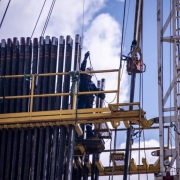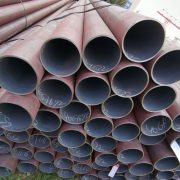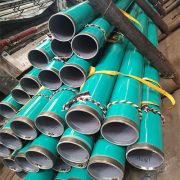石油・ガス探査における鋼管の重要な役割を探る
導入
鋼管は石油とガスに欠かせないもので、過酷な条件下でも比類のない耐久性と信頼性を発揮します。探査と輸送に欠かせないこれらのパイプは、高圧、腐食環境、過酷な温度に耐えます。このページでは、石油とガスの探査における鋼管の重要な機能について説明し、掘削、インフラストラクチャ、安全性における鋼管の重要性について詳しく説明します。適切な鋼管を選択することで、この厳しい業界で運用効率を高め、コストを削減できる方法をご覧ください。
I. 石油・ガス産業向け鋼管の基礎知識
1. 用語の説明
API: の略称 アメリカ石油協会.
OCTG: の略称 石油産業向け鋼管オイルケーシングパイプ、オイルチューブ、ドリルパイプ、ドリルカラー、ドリルビット、サッカーロッド、パップジョイントなど。
オイルチューブ: チューブは、油井での抽出、ガス抽出、水注入、酸破砕に使用されます。
ケース: 壁の崩壊を防ぐためのライナーとして、地表から掘削されたボーリング孔に降ろされるチューブ。
ドリルパイプ: ボーリング孔を掘る際に使用するパイプ。
ラインパイプ: 石油やガスを輸送するために使用されるパイプ。
カップリング: 2 本の内ねじ付きパイプを接続するために使用されるシリンダー。
カップリング材質: カップリングの製造に使用されるパイプ。
API スレッド: API 5B規格で規定されたパイプねじ。油管用丸ねじ、ケーシング用短丸ねじ、ケーシング用長丸ねじ、ケーシング用部分台形ねじ、ラインパイプ用ねじなど。
プレミアム接続: 独自のシーリング プロパティ、接続プロパティ、およびその他のプロパティを持つ非 API スレッド。
失敗: 特定の使用条件下での変形、破損、表面損傷、および本来の機能の喪失。
失敗の主な形態: 破裂、滑り、破裂、漏れ、腐食、接着、摩耗など。
2. 石油関連規格
API 仕様 5B、第 17 版 – ケーシング、チューブ、ラインパイプのねじのねじ切り、ゲージング、ねじ検査の仕様
API 仕様 5L、第 46 版 – ラインパイプの仕様
API 仕様 5CT、第 11 版 – ケーシングとチューブの仕様
API 仕様 5DP、第 7 版 – ドリルパイプの仕様
API 仕様 7-1、第 2 版 – ロータリードリルステムエレメントの仕様
API 仕様 7-2、第 2 版 – 回転肩付きねじ接続部のねじ切りおよびゲージの仕様
API 仕様 11B、第 24 版 – サッカーロッド、研磨ロッドとライナー、カップリング、シンカーバー、研磨ロッドクランプ、スタッフィングボックス、ポンピングティーの仕様
ISO 3183:2019 – 石油・天然ガス産業 — パイプライン輸送システム用鋼管
ISO 11960:2020 – 石油・天然ガス産業 — 井戸のケーシングや配管に使用される鋼管
NACE MR0175 / ISO 15156:2020 – 石油・天然ガス産業 — 石油・ガス生産におけるH2S含有環境で使用する材料
II. オイルチューブ
1. オイルチューブの分類
オイルチューブは、非アプセットオイルチューブ (NU)、外部アプセットオイルチューブ (EU)、およびインテグラルジョイント (IJ) オイルチューブに分けられます。NU オイルチューブとは、チューブの端が中厚で、直接ねじを回してカップリングをもたらすことを意味します。アプセットチューブとは、両方のチューブの端が外部にアプセットされ、次にねじを切ってカップリングされることを意味します。インテグラルジョイントチューブとは、チューブの一方の端が外部ねじでアプセットされ、もう一方の端がカップリングなしで直接接続された内部ねじでアプセットされていることを意味します。
2. オイルチューブの機能
① 石油・ガスの採掘:油井・ガス井を掘削し、セメントで固めた後、油井内にチューブを設置して石油・ガスを地中に採掘します。
②注水:坑内圧力が不十分な場合、チューブを通して井戸内に水を注入します。
③ 蒸気注入:濃厚油の高温回収では、断熱された油管を通じて蒸気が坑井内に注入されます。
④ 酸性化破砕:油井掘削後期や油ガス井の生産性向上のため、油ガス層に酸性化破砕媒体や硬化材を投入する必要があり、媒体と硬化材は油管を通じて輸送されます。
3. オイルチューブの鋼種
オイルチューブの鋼材グレードは、H40、J55、N80、L80、C90、T95、P110 です。
N80はN80-1とN80Qに分けられ、両者の引張特性は同じです。2つの違いは出荷状態と衝撃性能の違いです。N80-1は出荷時に正規化された状態、または最終圧延温度が臨界温度Ar3より高い場合、空冷後に張力が低下し、正規化の代わりに熱間圧延に使用できるため、衝撃や非破壊検査は必要ありません。N80Qは焼入れ(焼き入れ焼戻し)熱処理が必要で、衝撃機能はAPI 5CTの規定に準拠する必要があり、非破壊検査を行う必要があります。
L80はL80-1、L80-9Cr、L80-13Crに分かれており、機械的性質や納期は同じです。用途、製造難易度、価格の違い:L80-1は一般用、L80-9CrとL80-13Crは耐腐食性の高いチューブで、製造が難しく、高価で、通常は重腐食井で使用されます。
C90 と T95 は、C90-1、C90-2 と T95-1、T95-2 の 1 型と 2 型に分けられます。
4. オイルチューブによく使用される鋼種、鋼名、納入状況
J55 (37Mn5) NUオイルチューブ: 焼鈍ではなく熱間圧延
J55 (37Mn5) EUオイルチューブ:全長アプセット後の正規化
N80-1 (36Mn2V) NUオイルチューブ: 焼鈍ではなく熱間圧延
N80-1 (36Mn2V) EUオイルチューブ: 全長 圧縮後正規化
N80-Q (30Mn5) オイルチューブ: 30Mn5、全長焼戻し
L80-1 (30Mn5) オイルチューブ: 30Mn5、全長焼戻し
P110 (25CrMnMo) オイルチューブ: 25CrMnMo、全長焼戻し
J55 (37Mn5) カップリング: 熱間圧延オンライン 焼鈍
N80 (28MnTiB) カップリング: 全長焼戻し
L80-1 (28MnTiB) カップリング: 全長強化
P110 (25CrMnMo) カップリング: 全長焼戻し
III. ケーシングパイプ
1. ケーシングの分類と役割
ケーシングは、油井やガス井の壁を支える鋼管です。掘削深度や地質条件の違いにより、各井戸では数層のケーシングが使用されます。ケーシングを井戸に降ろした後、セメントで固めますが、油管や掘削管とは異なり、再利用できず、使い捨ての消耗品です。そのため、ケーシングの消費量は油井管全体の70%以上を占めています。ケーシングは用途により、導体ケーシング、中間ケーシング、生産ケーシング、ライナーケーシングに分けられ、油井における構造は図1に示されています。

①導体ケース: 通常、API グレードの K55、J55、または H40 を使用する導体ケーシングは、坑口を安定させ、直径が通常約 20 インチまたは 16 インチの浅い帯水層を隔離します。
②中間ケーシング: 中間ケーシングは、多くの場合 API グレードの K55、N80、L80、または P110 で作られ、不安定な地層や変化する圧力ゾーンを隔離するために使用され、一般的な直径は 13 3/8 インチ、11 3/4 インチ、または 9 5/8 インチです。
③製造ケース: 生産ケーシングは、API グレード J55、N80、L80、P110、Q125 などの高級鋼で作られており、生産圧力に耐えられるように設計されており、通常、直径は 9 5/8 インチ、7 インチ、または 5 1/2 インチです。
④ライナーケース: ライナーは、API グレードの L80、N80、または P110 などの材料を使用して、通常の直径が 7 インチ、5 インチ、または 4 1/2 インチの井筒を貯留層まで延長します。
⑤チューブ: チューブは API グレード J55、L80、または P110 を使用して炭化水素を地表まで輸送し、直径は 4 1/2 インチ、3 1/2 インチ、または 2 7/8 インチから選択できます。
IV. ドリルパイプ
1. 掘削工具用パイプの分類と機能
掘削ツールの角型ドリルパイプ、ドリルパイプ、加重ドリルパイプ、ドリルカラーがドリルパイプを形成します。ドリルパイプは、ドリルビットを地面から井戸の底まで駆動するコア掘削ツールであり、地面から井戸の底までのチャネルでもあります。ドリルパイプには、3つの主要な役割があります。
① ドリルビットを駆動して掘削するためのトルクを伝達する。
② ドリルビットの重量を利用して井戸底の岩盤の圧力を破る。
③洗浄液を輸送する、すなわち、掘削泥水を高圧泥水ポンプを通して地中を通過させ、掘削柱内の泥水をボーリングホールに流入させて井戸底に流し込み、岩石の破片を洗い流すとともにドリルビットを冷却し、岩石の破片を柱の外面と井戸壁の間の環状部を通して地中へ戻し、井戸を掘削する目的を達成する。
ドリルパイプは、掘削プロセスで使用され、引張、圧縮、ねじり、曲げ、その他の応力など、さまざまな複雑な交互負荷に耐えます。内面は、高圧泥による洗掘や腐食にもさらされます。
(1)角型ドリルパイプ: 角型ドリルパイプには、四角形と六角形の2種類があります。中国の石油掘削パイプでは、ドリルコラム1セットにつき、通常、四角形のドリルパイプが使用されています。その仕様は、63.5mm(2-1/2インチ)、88.9mm(3-1/2インチ)、107.95mm(4-1/4インチ)、133.35mm(5-1/4インチ)、152.4mm(6インチ)などです。使用される長さは通常12〜14.5mです。
(2)ドリルパイプ: ドリルパイプは井戸を掘るための主な道具で、角形のドリルパイプの下端に接続され、井戸の掘削が深くなるにつれて、ドリルパイプはドリル柱を次々に長くしていきます。ドリルパイプの規格は、60.3mm(2-3/8インチ)、73.03mm(2-7/8インチ)、88.9mm(3-1/2インチ)、114.3mm(4-1/2インチ)、127mm(5インチ)、139.7mm(5-1/2インチ)などです。
(3)高耐久性ドリルパイプ: 加重ドリルパイプは、ドリルパイプとドリルカラーを接続する移行ツールであり、ドリルパイプの力条件を改善し、ドリルビットへの圧力を高めることができます。加重ドリルパイプの主な仕様は、88.9mm(3-1/2インチ)と127mm(5インチ)です。
(4)ドリルカラー: ドリルカラーは、剛性の高い特殊な厚肉パイプであるドリルパイプの下部に接続され、ドリルビットに圧力をかけて岩を破砕し、直井掘削時のガイドの役割を果たします。ドリルカラーの一般的な仕様は、158.75mm(6-1/4インチ)、177.85mm(7インチ)、203.2mm(8インチ)、228.6mm(9インチ)などです。
V. ラインパイプ
1. ラインパイプの分類
ラインパイプは、石油・ガス業界で石油、精製油、天然ガス、水道管の輸送に使用され、略称は鋼管です。石油・ガスの輸送パイプラインは、幹線、支線、都市パイプラインネットワークパイプラインに分かれています。幹線パイプライン輸送の3種類の規格は、通常、∅406〜1219mm、壁厚10〜25mm、鋼種X42〜X80です。支線パイプラインと都市パイプラインネットワークパイプラインの規格は通常、∅114〜700mm、壁厚6〜20mm、鋼種X42〜X80です。鋼種はX42〜X80です。ラインパイプには、溶接タイプとシームレスタイプがあります。溶接ラインパイプは、シームレスラインパイプよりも多く使用されています。
2. ラインパイプの規格
API 仕様 5L – ラインパイプの仕様
ISO 3183 – 石油および天然ガス産業 – パイプライン輸送システム用鋼管
3. PSL1とPSL2
PSLは、 製品仕様レベルラインパイプ製品の規格レベルはPSL 1とPSL 2に分かれており、品質レベルもPSL 1とPSL 2に分かれています。PSL 2はPSL 1よりも高く、2つの規格レベルは試験要件が異なるだけでなく、化学組成と機械的特性要件も異なるため、API 5L規則に従って契約条件では、規格、鋼種、その他の共通指標を指定するほか、製品の規格レベル、つまりPSL 1かPSL 2かを明記する必要があります。PSL 2は化学組成、引張特性、衝撃力、非破壊検査などの指標がPSL 1よりも厳格です。
4. ラインパイプの鋼種、化学成分および機械的性質
ラインパイプ鋼のグレードは、低級から高級まで、A25、A、B、X42、X46、X52、X60、X65、X70、X80 に分類されます。詳細な化学組成と機械的特性については、API 5L 仕様、第 46 版を参照してください。
5. ラインパイプの水圧試験および非破壊検査の要件
ラインパイプは分岐ごとに油圧テストを行う必要がありますが、この規格では油圧の非破壊生成は許可されていません。これも API 規格と当社の規格の大きな違いです。PSL 1 では非破壊テストは必要ありませんが、PSL 2 では分岐ごとに非破壊テストを行う必要があります。
VI. プレミアム接続
1. プレミアム接続の導入
プレミアムコネクションは、API スレッドとは異なる独自の構造を持つパイプスレッドです。既存の API スレッドオイルケーシングは油井開発で広く使用されていますが、一部の油田の特殊な環境では、その欠点が明確に示されています。API 丸ねじパイプコラムは、シール性能が優れていますが、ねじ部分が負担する引張力はパイプ本体の強度の 60% ~ 80% にしか相当しないため、深井戸の開発には使用できません。API 偏向台形ねじパイプコラムは、引張性能が API 丸ねじ接続よりもはるかに高いものの、シール性能はそれほど良くありません。コラムの引張性能は API 丸ねじ接続よりもはるかに高いものの、シール性能はあまり良くないため、高圧ガス井の開発には使用できません。また、ねじ付きグリースは95℃以下の環境でのみその役割を果たすことができるため、高温井戸の採掘には使用できません。
API 丸ねじおよび部分台形ねじ接続と比較して、プレミアム接続は次の点で画期的な進歩を遂げました。
(1)優れた密封性、弾性と金属密封構造設計により、ジョイントガス密封が降伏圧力内でチューブ本体の限界に達するのを防ぎます。
(2)接続部の強度が高く、オイルケーシングの特殊なバックル接続部と接続し、その接続強度はチューブ本体の強度に達するかそれを超え、滑りの問題を根本的に解決します。
(3)材料の選択と表面処理工程の改善により、糸がバックルに固着する問題を基本的に解決しました。
(4)構造の最適化により、接合部の応力分布がより合理的になり、応力腐食に対する耐性が向上する。
(5)肩部構造を合理的に設計することにより、バックルの操作がより容易に行える。
石油・ガス業界は、パイプ技術の大きな進歩を示す 100 を超える特許取得済みのプレミアム接続を誇っています。これらの特殊なねじ設計は、優れた密閉機能、接続強度の向上、環境ストレスに対する耐性の強化を実現します。高圧、腐食環境、極端な温度などの課題に対処することで、これらのイノベーションは、世界中の石油に安全な作業で優れた信頼性と効率性を保証します。プレミアム接続の継続的な研究開発は、より安全で生産性の高い掘削作業をサポートする上での極めて重要な役割を強調し、エネルギー分野における技術的卓越性への継続的な取り組みを反映しています。
VAM® 接続: 厳しい環境でも堅牢なパフォーマンスを発揮することで知られる VAM® 接続は、高度な金属対金属のシーリング技術と高トルク機能を備えており、深井戸や高圧貯留層での信頼性の高い動作を保証します。
TenarisHydril ウェッジシリーズ: このシリーズは、Blue®、Dopeless®、Wedge 521® などの幅広い接続部を提供し、優れた気密性、圧縮力および張力に対する耐性で知られ、操作の安全性と効率性を高めます。
TSH®ブルー: Tenaris が設計した TSH® Blue コネクションは、独自のダブルショルダー設計と高性能スレッドプロファイルを採用しており、重要な掘削アプリケーションにおいて優れた耐疲労性と簡単な取り付けを実現します。
Grant Prideco™ XT® 接続: NOV が設計した XT® 接続部には、独自の金属対金属シールと堅牢なねじ山形状が組み込まれており、優れたトルク容量と耐摩耗性が保証され、接続部の動作寿命が延長されます。
ハンティングシールロック®接続: 金属同士のシールと独自のねじプロファイルを特徴とする Hunting の Seal-Lock® 接続は、陸上および海上掘削作業の両方において優れた耐圧性と信頼性を備えていることで知られています。
結論
結論として、石油・ガス産業に不可欠な鋼管の複雑なネットワークには、厳しい環境と複雑な運用要件に耐えるように設計されたさまざまな特殊機器が含まれています。健全な壁を支えて保護する基礎ケーシング パイプから、抽出および注入プロセスで使用される多用途のチューブまで、各タイプのパイプは炭化水素の探査、生産、輸送において異なる目的を果たします。API 仕様などの標準により、これらのパイプ全体の均一性と品質が保証され、プレミアム接続などのイノベーションにより、厳しい条件下でのパフォーマンスが向上します。テクノロジーの進化に伴い、これらの重要なコンポーネントが進化し、世界のエネルギー運用の効率と信頼性が向上します。これらのパイプとその仕様を理解することで、現代のエネルギー部門のインフラストラクチャにおけるパイプの不可欠な役割が強調されます。






